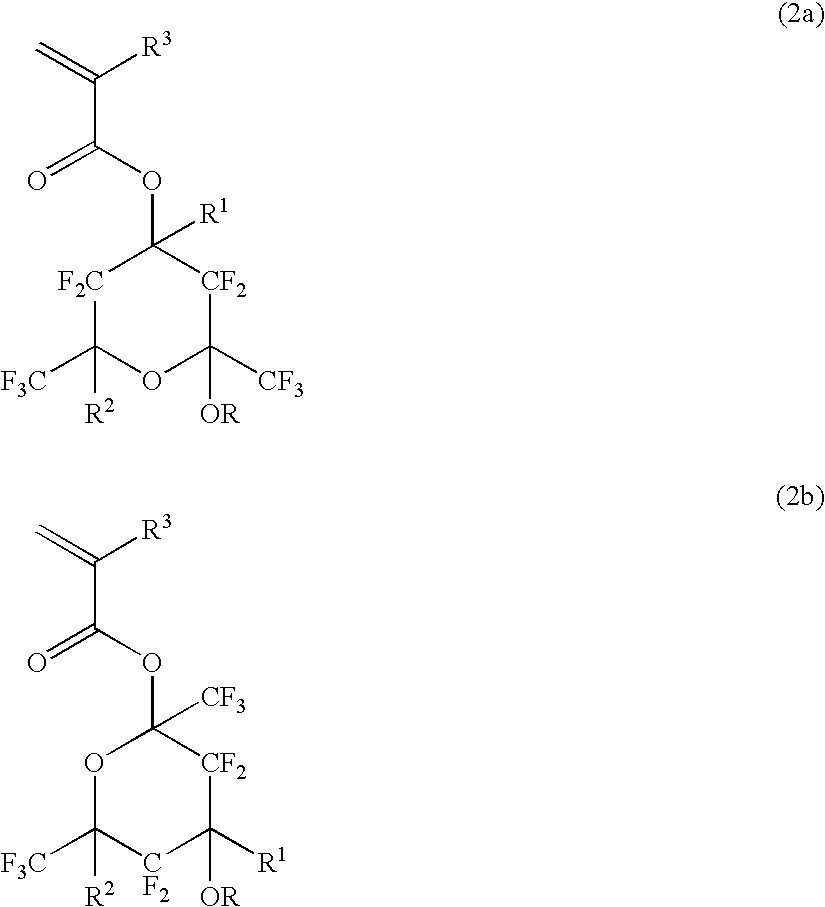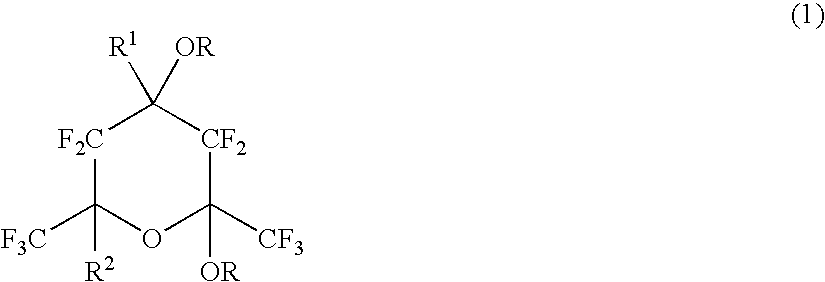Polymerizable fluorinated compound, making method, polymer, resist composition and patterning process
a fluorinated compound and polymer technology, applied in the field of fluorinated polymers, can solve the problems of increased line edge roughness, occupying left, and difficult to control the alkali solubility of resin, so as to minimize the surface roughness, minimize the line edge roughness, and minimize the etch resistance
- Summary
- Abstract
- Description
- Claims
- Application Information
AI Technical Summary
Benefits of technology
Problems solved by technology
Method used
Image
Examples
synthesis example 1
Monomer Synthesis Example 1
Synthesis of Monomer 1
[0292] A 3-L four-necked flask was charged with 113.8 g of 1,1,1,3,3,3-hexafluoro-2-propanol and 500 ml of tetrahydrofuran (THF). The flask was placed in a dry ice bath and cooled to an internal temperature below −60° C. while stirring the mixture in a nitrogen atmosphere. While the flask temperature was kept below −55° C., 500 ml of a n-hexane solution of 2.71M n-butyllithium was added dropwise followed by 2 hours of stirring at −30° C.
[0293] The flask was then placed in an ice bath, and 25.0 g of ethyl formate was added dropwise thereto. After the completion of dropwise addition, the ice bath was removed. The flask was placed in an oil bath, instead, where stirring was continued for 24 hours while keeping the internal temperature at 50° C.
[0294] The oil bath was removed. The flask was placed in an ice bath, instead. While keeping the temperature below 10° C., 270 ml of a THF solution of 3.0M methylmagnesium chloride was added dr...
polymer synthesis example 2
Copolymerization of 3-ethyl-3-exo-tetracyclo[4.4.0.12.5.17.10]-dodecanyl methacrylate, 3-hydroxy-1-adamantyl methacrylate, 4,8-dioxatricyclo[4.2.1.03.7]nonan-5-on-2-yl methacrylate, and Monomer 1 (25 / 25 / 40 / 10)
[0311] A 300-mL flask was charged with 5.31 g of 3-ethyl-3-exo-tetracyclo[4.4.0.12.5.17.10]dodecanyl methacrylate, 4.58 g of 3-hydroxy-1-adamantyl methacrylate, 6.95 g of 4,8-dioxatricyclo[4.2.1.03.7]nonan-5-on-2-yl methacrylate, 3.16 g of Monomer 1 and 40 g of PGMEA. Oxygen was expelled from the system, after which 0.25 g of AIBN was added to and fully dissolved in the mixture in a nitrogen atmosphere. To a 300-ml flask which was charged with 20 g of PGMEA and kept at a temperature of 80° C., the monomer solution was added dropwise over 4 hours. After the completion of dropwise addition, stirring was continued at 80° C. for a further 2 hours. The reaction mixture was cooled down to room temperature and admitted into 500 g of n-hexane whereupon a polymer precipitated. The pol...
polymer synthesis example 3
Copolymerization of 3-ethyl-3-exo-tetracyclo[4.4.0.12.5.17.10]-dodecanyl methacrylate, 3-hydroxy-1-adamantyl methacrylate, 4,8-dioxatricyclo[4.2.1.03.7]nonan-5-on-2-yl methacrylate, and Monomer 1 (25 / 25 / 30 / 20)
[0313] A 300-mL flask was charged with 4.96 g of 3-ethyl-3-exo-tetracyclo[4.4.0.12.5.17.10]dodecanyl methacrylate, 4.27 g of 3-hydroxy-1-adamantyl methacrylate, 4.86 g of 4,8-dioxatricyclo[4.2.1.03.7]nonan-5-on-2-yl methacrylate, 5.90 g of Monomer 1 and 40 g of PGMEA. Oxygen was expelled from the system, after which 0.25 g of AIBN was added to and fully dissolved in the mixture in a nitrogen atmosphere. To a 300-ml flask which was charged with 20 g of PGMEA and kept at a temperature of 80° C., the monomer solution was added dropwise over 4 hours. After the completion of dropwise addition, stirring was continued at 80° C. for a further 2 hours. The reaction mixture was cooled down to room temperature and admitted into 500 g of n-hexane whereupon a polymer precipitated. The pol...
PUM
| Property | Measurement | Unit |
|---|---|---|
| Nanoscale particle size | aaaaa | aaaaa |
| Length | aaaaa | aaaaa |
| Length | aaaaa | aaaaa |
Abstract
Description
Claims
Application Information
 Login to View More
Login to View More - R&D
- Intellectual Property
- Life Sciences
- Materials
- Tech Scout
- Unparalleled Data Quality
- Higher Quality Content
- 60% Fewer Hallucinations
Browse by: Latest US Patents, China's latest patents, Technical Efficacy Thesaurus, Application Domain, Technology Topic, Popular Technical Reports.
© 2025 PatSnap. All rights reserved.Legal|Privacy policy|Modern Slavery Act Transparency Statement|Sitemap|About US| Contact US: help@patsnap.com



